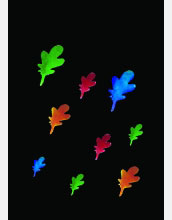| Posted: October 21, 2007 |
Photonic gel films hold promise |
|
(Nanowerk News) By alternating layers of two different polymers - one rigid and glassy, the other soft and easily swollen with liquid or vapor - researchers funded by the National Science Foundation (NSF) report they've created photonic gel crystals that can be tuned to reflect light of many different colors across the visible and near-infrared spectrum.
|
|
The research results, reported in the Oct. 21 online issue of Nature Materials by Principal Investigator Edwin Thomas and his colleagues at the Massachusetts Institute of Technology's department of materials science and engineering, demonstrate the degree to which these photonic materials are tunable through changes in the soft layer's thickness and index of refraction. The responsiveness of the photonic crystals makes them likely candidates for active components of display, sensory or telecommunication devices.
|
 |
| Photonic gel crystals demonstrate the "tunability" of materials made from alternating layers of hard and soft polymers. The soft polymers are easily swollen with liquid or vapor, causing the materials to reflect different colors of light based on the way their molecules are chemically "tuned". (Image: Courtesy of Edwin L. Thomas, MIT)
|
|
"This is an ingenious and easy-to-implement method for making photonic materials whose optical properties can be readily tuned over a wide range [of the spectrum]," said Andrew Lovinger, director of the polymers program at NSF, which funded this research.
|
|
In one example, the researchers show very large, reversible optical changes by varying the salt content of a water solution in which these films are dipped. Multicolor patterns can be made by sequential coating of films, with the color of each region depending on the degree to which their molecules are chemically interconnected.
|
|
"We expect these photonic gels will lead to many novel applications, including colorimetric sensors, active components of simple display devices, and electrically controlled tunable optically pumped lasers, photonic switches and multiband filters," Thomas said.
|
|
NSF funded the research in 2003 through a three-year grant aimed at creating new nanomaterials that are tunable through magnetic, chemical or other techniques. Following the discovery of intriguing new effects by Thomas and his colleagues involving the interaction of light and sound in these nanomaterials, his grant was extended for two additional years through a "special creativity award."
|
|
About NSF
|
|
The National Science Foundation (NSF) is an independent federal agency that supports fundamental research and education across all fields of science and engineering, with an annual budget of $5.92 billion. NSF funds reach all 50 states through grants to over 1,700 universities and institutions. Each year, NSF receives about 42,000 competitive requests for funding, and makes over 10,000 new funding awards. The NSF also awards over $400 million in professional and service contracts yearly.
|
|
Source: NSF
|

